Taking Care of Business (and Installers!)
by Peter J. Marcucci
Photos Courtesy No Lift Systems
My first day as a fabricator was sometime in 1985. There were very few safety aids available for shops or jobsites in those days. Cut pieces were hand-carried throughout every stage, and then loaded on a pickup truck. When arriving at the jobsite, pieces were either brought in on a dolly or cart, a small device with two small wheels, or just hand-carried, while steps and stairways were traversed with a tight grip, a strong back, and a deep grunt. Needless to say, everyone who worked there was strong and dedicated to getting it done.
As the years passed, the folks who stayed grew more efficient at creating quality work. What nobody saw, especially the installers, however, was that all those years of heavy lifting were slowly and quietly taking its toll on their bodies. Yes, our installers were finding better ways to finish their work, but hardly any effort was put into finding better ways to move materials into the customer’s home. Those installers, who’d now grown into super installers and able to say yes to any problem, had bodies that were now saying “No!” Their backs, shoulders, wrists and knees had had enough, and many were facing an untimely early retirement. All that knowledge, patience and skill would walk (or hobble) away, and the learning cycle, along with hundreds of mistakes, would begin again.
Now fast forward to 2024. Wow, how have things changed! Breakthroughs and inventions to improve safety are aplenty, and careers that might have ended early for us old timers, are now extended decades into the future by progressive shops willing to invest in the latest safety equipment. One of those progressives who continue to lead the industry in safety is Aaron Crowley, a former countertop shop owner, and long-time safety equipment developer, writer, and now pod caster. Crowley has been a true safety advocate from the get-go, when he opened Crowley’s Granite & Quartz in Tualatin, Oregon in 1998. Aaron has also recently been made Chairman of The Natural Stone Institute Safety Committee, and as you’ll see, he’s not afraid to speak his mind.
“What we’re up against is an old school mentality that still believes it is okay to expect another human being to sacrifice their health and future quality of life for an install job that may only last a few years. Some companies are oblivious to it, and some just don’t care, enough to change. Unfortunately, the inevitable result of this mentality is an ever-shrinking pool of qualified installers.
“If you do the math, an 85 square-foot kitchen weighs about 1,330 pounds. If a crew picks those countertops up to load their rig, picks them up again to unload the rig, and then picks them up again to set them on the cabinets, that’s lifting over 4,000 pounds per day, 20,000 pounds per week. That’s over a million pounds per year in cumulative lifting! So when you’re trying to attract employees to install for you, it’s an uphill battle trying to find people who are willing to work that hard and take that risk for installer wages. The easiest way to solve this problem is to protect the installers who you already employ, so you don’t lose them due to a lifting-related injury. ”
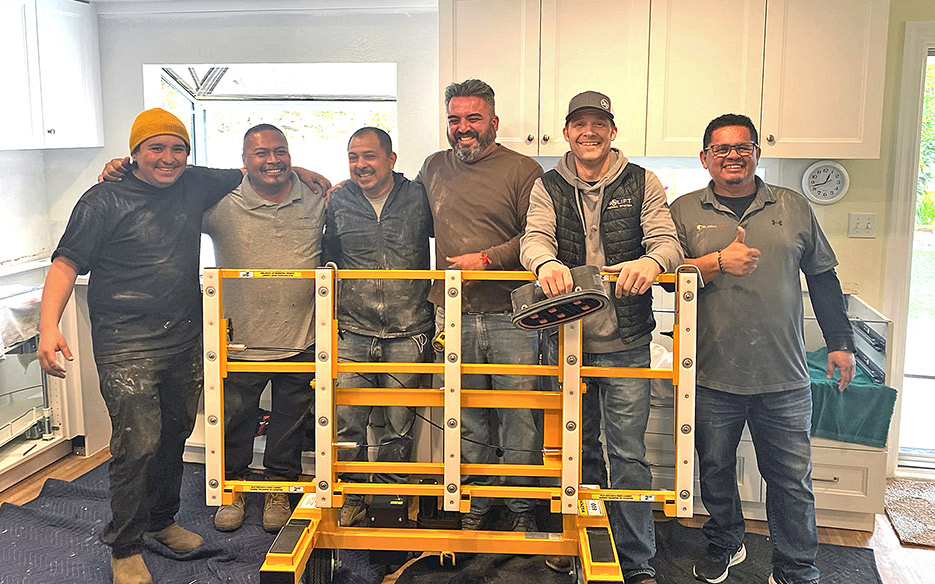 |
|
Aaron Crowley with a very happy crew at Block Tops Anaheim, CA. Nate Kolenski, owner of Block Tops is a pioneer in the stone industry, outfitting all his install crews with No Lift Systems. |
The Alternative
Crowley, not being a guy who just talks the talk, walked the walk to his drawing board. He built many prototypes that were extensively tested in the field by his own install crew before coming up with a working design to facilitate the safe transporting and lifting of slab counters, no matter the jobsite conditions.
Finally, Crowley’s No Lift Install System was fleshed-out, tested, modified, tested again, patented and put into production. As you’ll see in the captioned photos, the system has many great benefits, and has been a great success, and there’s even an updated version for 2024. Here’s why it’s been a hit with the industry.
The two main features of the No Lift Install System are the frame lifting mechanism and the rotating mechanism. The lifting mechanism is a remote controlled 12v actuator. This is what lifts the countertop to cabinet height. Once the countertop is at the approximate cabinet height, the frame that holds the countertop is unlocked and rotated into the horizontal position and locked into place. Then, after the final height is set, using the remote control, a security hook (called the Sheppard Hook) is released, allowing the countertop to easily roll on to the cabinet by means of 20 transfer balls that sit just above the frame. The transfer balls make for a very stable yet frictionless surface.
Other features of the No Lift Install System are the automatic drop-away feet that facilitate placement onto the cabinet when a countertop is transported with the wall edge down instead of up. As for wheels and castors, this is where the rubber meets the road, explained Aaron. “We found that the weight and the stress that a granite countertop puts on those castors wears them out over time, and they become fatigued and unstable. They also don’t pivot well when worn, and when you’re in a small kitchen trying to turn in all directions, you need to have precise control. So the low friction, locking castors we use, each have a 3,500 pound weight capacity, even though we are only putting from 600 to 900 pounds on the cart. As for tires, they are non-marring and non-binding. We tested every wheel, tire and castor known to mankind, and wound up with 10 inch by 4 inch solid rubber tires made by a company called Ameritire from Arizona. These tires were developed exclusively for situations like installations and designed to go going over curbs, rocks, thresholds, cords and drop cloths. They are perfectly designed for what we do.”
As for options, there’s a whole slew of really cool accessories. One of particular interest is called the Roll-A-Ramp that’s made out of aluminum. It’s great for those extra-long steps or that freshly poured concrete walkway that the supervisor forgot to tell you about on installation day. It weighs 55 pounds, has a 900 pound capacity, and is easily transportable. It is also infinitely expandable using the optional extensions. Another is the Edge Slider, used for installing laminated or mitered edge countertops. Trust me, the list of cool stuff goes on.
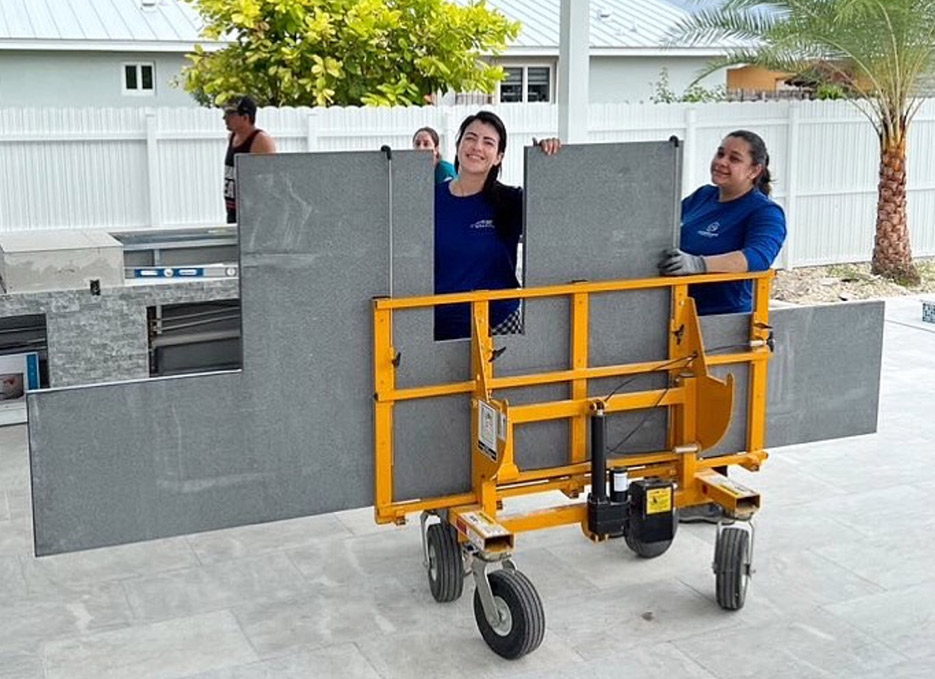 |
|
Above: The No Lift expands the labor pool, enabling women to join the ranks of highly skilled slab installers, something utterly unheard of in the past.
Below: Designed with installer safety in mind, the Power Tilt No Lift cart uses outrigger supports to stabilize, rotate and help installers easily move large islands into position. |
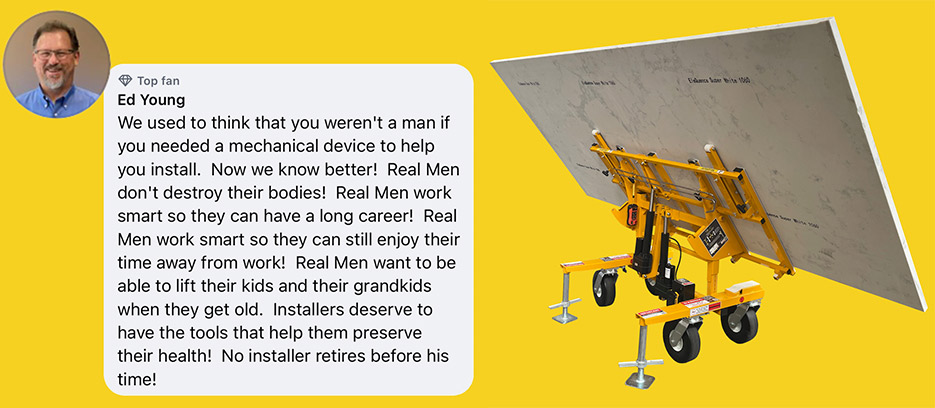 |
|
Below: The Roll-a-Ramp aluminum accessory makes navigating steps even easier. |
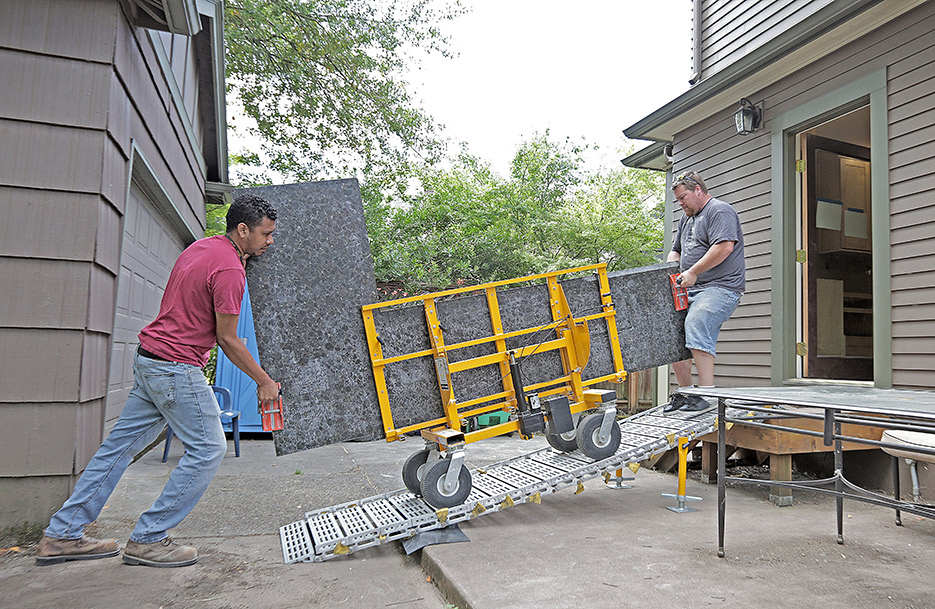 |
Changing an Industry Mindset
“There’s a laundry list of ways that the old school lift and carry approach costs the company in the short term and the long term,” continued Aaron. “In the short term, companies will send extra installers or redeploy other install crews to help get heavy and awkward counters installed. Sometimes, they break large or fragile countertops that otherwise wouldn’t have broken had they used the No Lift Install System. As for the long term, it’s very common that after four or five years of lifting, an installer recognizes what’s happening to his body and he quits before his health is completely destroyed. Well, you just lost an highly-skilled installer after years of training. That’s an unimaginable expense for the company.
“Additionally, you also have a compounding effect, because there’s a labor shortage right now. This shortage is across all industries, and not unique to stone fabrication. So as an employer, if the number one qualification for a prospective installer is they’ve got to be as strong as a football lineman, they’re going to think, ‘Man, this is hard work! Do I really want to do this day in and day out?!’
“This is a huge problem right now for shops. Unfortunately, too many shop owners don’t want to admit that this is a problem.
They really struggle to see the correlation between a highly-skilled guy who can install or fix and job in the field, and the inevitable fact that the wear and tear and tear on his body is going to catch up with him. That employer is going to lose a skilled craftsman, and that craftsman is going to lose his career. It’s a tragedy in my opinion, and our goal at No Lift is to change that industry mindset by presenting a better way, so that highly skilled craftsmen can continue to practice their trade and their employers can prosper.”
Crowley believes that the status quo isn’t sustainable and that eventually, all countertops will be installed using mechanical devices like the No lift..
“Once you come to grips with the fact that it’s not okay to ask somebody to make this kind of sacrifice, the follow-up changes are easy decisions to make. Once you’ve got one of our carts in the field, you’re not going to break countertops, you’re going to have fewer injuries, and you’re going to significantly reduce the labor needed to get big countertops installed on site.”
“Some companies get it, and they willingly invest in equipment like the No Lift to protect their installers and protect their profits.
“For those who don’t get it, they will continue to suffer the loss of skilled employees, broken counters, and excess labor costs… and in the end, they will be forced to make this change merely to survive.”
In closing, it’s clear, that if the stone fabrication industry as a whole doesn’t make the choice to take better care of its employees, state and federal regulators will. Just look at the silicosis issue in California. Preventing back injuries and silicosis are big issues in the news these days, and are looming priori-ties that companies are facing. If Stone industry companies aren’t proactive about taking responsibility for the safety of their workers, someone else will step in, and you might not like it.
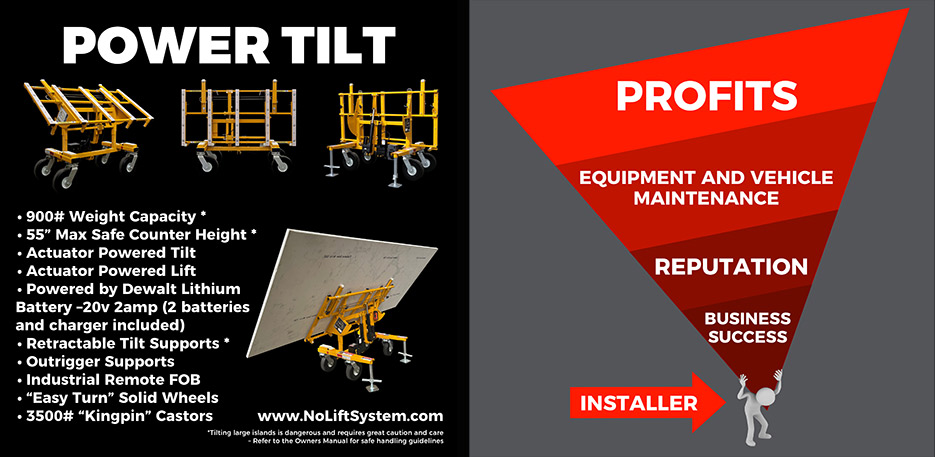 |
|
“Every stone shop literally depends on whether its installers can get the counters installed in the client’s home. If you can’t get the counters installed, you don’t have a stone business.”
|
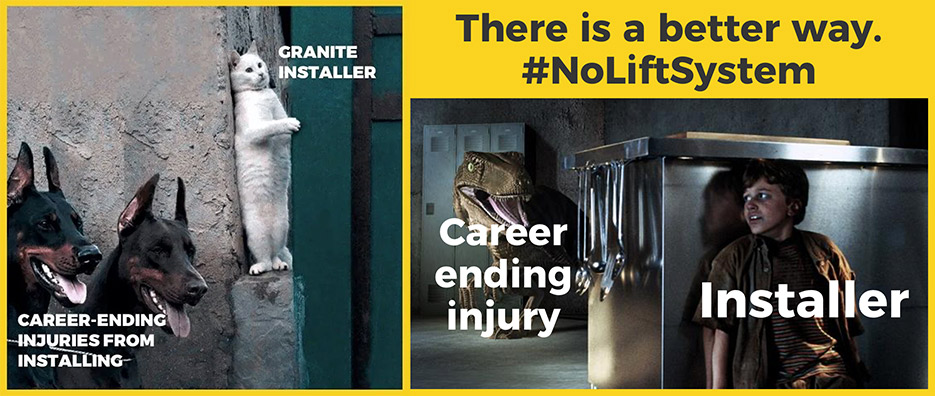 |
|
Below: Guys in the field clearly love their carts. A frequent comment is, “I can’t imagine working without one, now.” |
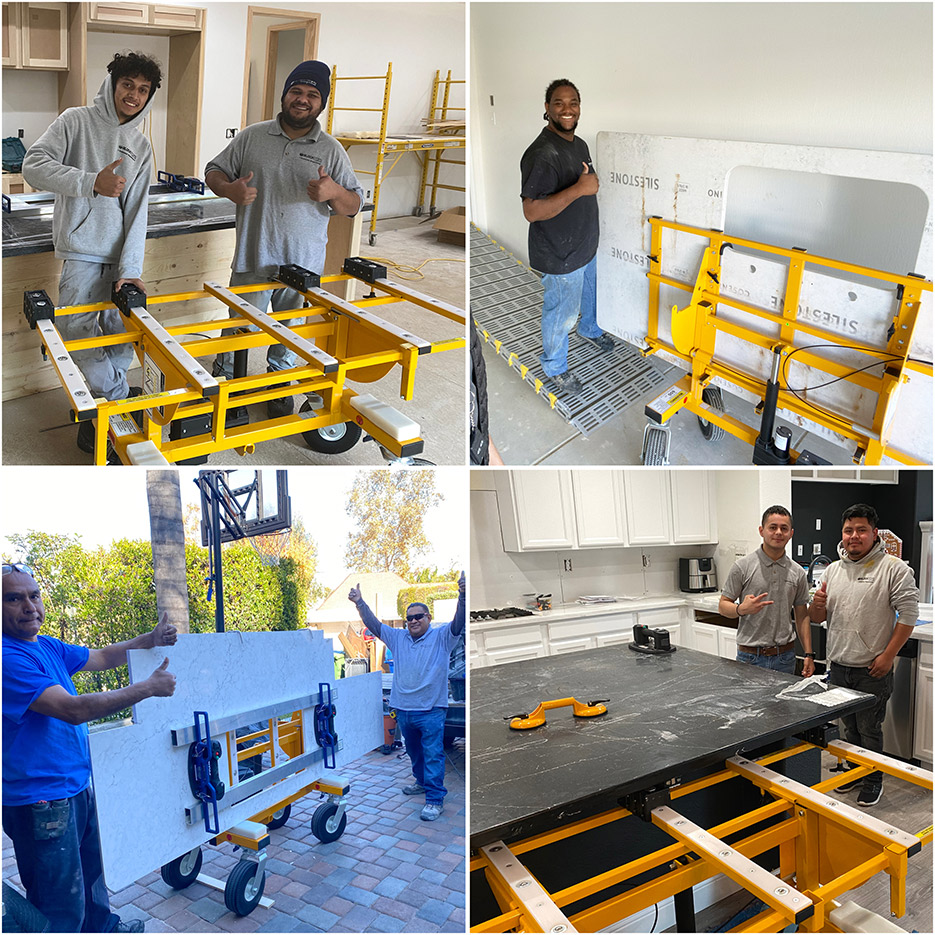 |
For more information on safety and the No Lift Install System, go to www.noliftsystem.com or watch the over 200 videos at https://www.youtube.com/@noliftsystem .